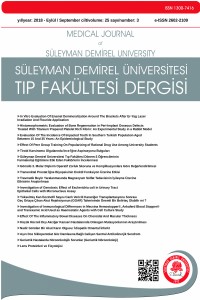Abstract
Vücudumuzda
bulunan bazı doku ve organlar dışında genel itibari ile beslenme damar yolu ile
olur. Fenestralı kılcal damarlar doku içerisine yayılarak dokunun ihtiyaç
duyduğu oksijeni eritrositler, besin maddelerini de kanın serum kısmı ile
taşır. Doku ihtiyacı olan metabolitleri aldıktan sonra artıklarını da yine
fenestralı kılcal damarlar ve lenf damaları sayesinde geri verir. Lens vücutta
kan dolaşımının aktif olarak bulunmadığı ve canlılığını koruyan nadir
yapılardan bir tanesidir. Beslenmesini ve artık boşaltımını aköz hümöre bağımlı
olarak gerçekleştirir. Lensin metabolizması bu yüzden özelleşmiş bir döngüye
sahiptir.
Vücuttaki tüm
organ ve dokuların temel yapı taşı proteindir. Lens vücutta hacim başına en
fazla protein olan dokulardan biridir. İçeriğindeki yüksek protein miktarı
lensin ihtiyaç duyduğu yüksek kırıcılık indeksine ve refraktif indeksin
oluşmasını sağlar. Aynı zamanda lensin saydamlılığının korunmasında da lens
proteinleri önemli görevler üstlenir. Bununla birlikte lens hücrelerinin
birbiri ile madde alışverişi sağlayabilmesi için de fonksiyonlar görür. Lens
hücreleri içerisindeki proteinler ise hücre şeklinin korunmasında görev
yaparlar.
References
- 1. Hoehenwarter W, Klose J, Jungblut PR. Eye lens proteomics. Amino acids. 2006;30(4):369-89.
- 2. Huang C-H, Wang Y-T, Tsa C-F, Chen Y-J, Lee J-S, Chiou S-H. Phosphoproteomics characterization of novel phosphorylated sites of lens proteins from normal and cataractous human eye lenses. Moleculer Vision. 2011;17:186-96.
- 3. Andley UP. Crystallins in the eye: Function and pathology. Progress in retinal and eye research. 2007;26(1):78-98.
Abstract
Except for some of the tissues and organs found in our body, nutrition generally takes place via the vein. Fenestral capillary vessels spread through the tissue to touch the needy oxygen erythrocytes, and the nutrients are carried by the blood serum part. Once the tissue has taken up the metabolites it needs, it also restores its debris through its fenestral capillaries and lymph vessels. The lens is a rare tissue of the body that does not have an active blood circulation and protects its vitality. It performs feeding and residual discharge dependent on aqueous humor. The metabolism of the lens thus has a specialized loop.
The basic building block of all the organs and tissues in the body is protein. The lens is one of the tissues with the highest protein per volume in the body. The high amount of protein in it provides the refractive index and refractive index required by the lens. At the same time, lens proteins play an important role in preserving the transparency of the lens. However, it also functions to allow the lens cells to exchange materials with each other. The proteins in the lens cells function in protecting the cell shape.
Keywords
References
- 1. Hoehenwarter W, Klose J, Jungblut PR. Eye lens proteomics. Amino acids. 2006;30(4):369-89.
- 2. Huang C-H, Wang Y-T, Tsa C-F, Chen Y-J, Lee J-S, Chiou S-H. Phosphoproteomics characterization of novel phosphorylated sites of lens proteins from normal and cataractous human eye lenses. Moleculer Vision. 2011;17:186-96.
- 3. Andley UP. Crystallins in the eye: Function and pathology. Progress in retinal and eye research. 2007;26(1):78-98.
Details
| Primary Language | Turkish |
|---|---|
| Subjects | Clinical Sciences |
| Journal Section | Reviews |
| Authors | |
| Publication Date | September 1, 2018 |
| Submission Date | July 2, 2017 |
| Acceptance Date | December 22, 2017 |
| Published in Issue | Year 2018 Volume: 25 Issue: 3 |
Süleyman Demirel Üniversitesi Tıp Fakültesi Dergisi/Medical Journal of Süleyman Demirel University is licensed under Creative Commons Attribution-NonCommercial-NoDerivs 4.0 International.


